Singapore Changi Airport: Operations, Strategy, and Analysis Report
VerifiedAdded on 2021/05/31
|16
|4783
|43
Report
AI Summary
This report provides a comprehensive analysis of Changi Airport's business operations. It begins with an executive summary and background, detailing the airport's history and its role as a major transportation hub in Southeast Asia. The report explores Changi's value chain, particularly focusing on air freight operations, including key milestones and enhancements. It examines sustainability practices, demand forecasting, and the future of the airport, including plans for Terminal 5. The analysis includes strategic planning, financial arrangements, and human resource management related to air freight operations. The report also identifies the airport's supply chain and various enhancements made to improve customer satisfaction, such as collaboration with airlines and the implementation of technology. Overall, the report offers insights into Changi Airport's strategies for success in the global market.
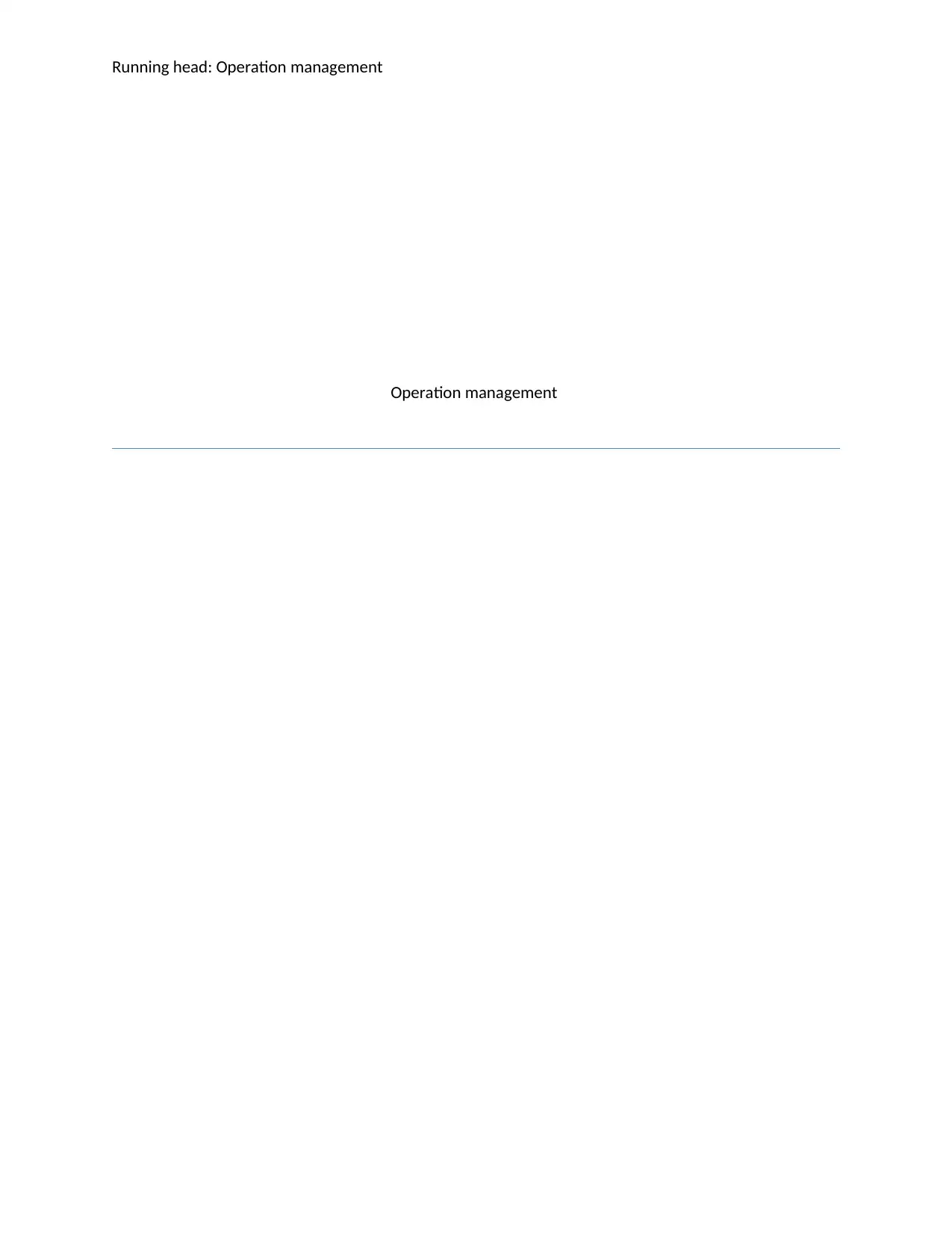
Running head: Operation management
Operation management
Operation management
Paraphrase This Document
Need a fresh take? Get an instant paraphrase of this document with our AI Paraphraser
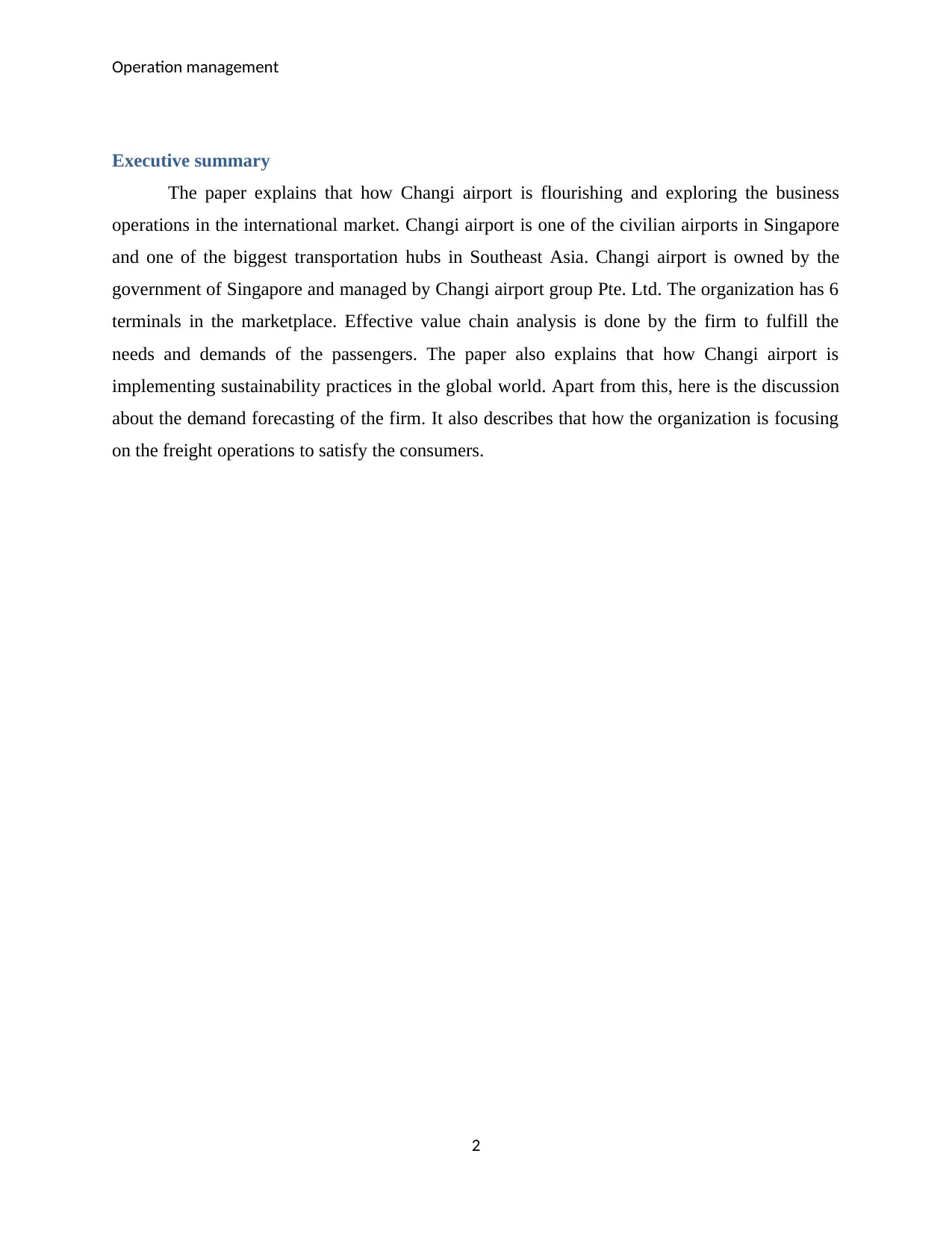
Operation management
Executive summary
The paper explains that how Changi airport is flourishing and exploring the business
operations in the international market. Changi airport is one of the civilian airports in Singapore
and one of the biggest transportation hubs in Southeast Asia. Changi airport is owned by the
government of Singapore and managed by Changi airport group Pte. Ltd. The organization has 6
terminals in the marketplace. Effective value chain analysis is done by the firm to fulfill the
needs and demands of the passengers. The paper also explains that how Changi airport is
implementing sustainability practices in the global world. Apart from this, here is the discussion
about the demand forecasting of the firm. It also describes that how the organization is focusing
on the freight operations to satisfy the consumers.
2
Executive summary
The paper explains that how Changi airport is flourishing and exploring the business
operations in the international market. Changi airport is one of the civilian airports in Singapore
and one of the biggest transportation hubs in Southeast Asia. Changi airport is owned by the
government of Singapore and managed by Changi airport group Pte. Ltd. The organization has 6
terminals in the marketplace. Effective value chain analysis is done by the firm to fulfill the
needs and demands of the passengers. The paper also explains that how Changi airport is
implementing sustainability practices in the global world. Apart from this, here is the discussion
about the demand forecasting of the firm. It also describes that how the organization is focusing
on the freight operations to satisfy the consumers.
2
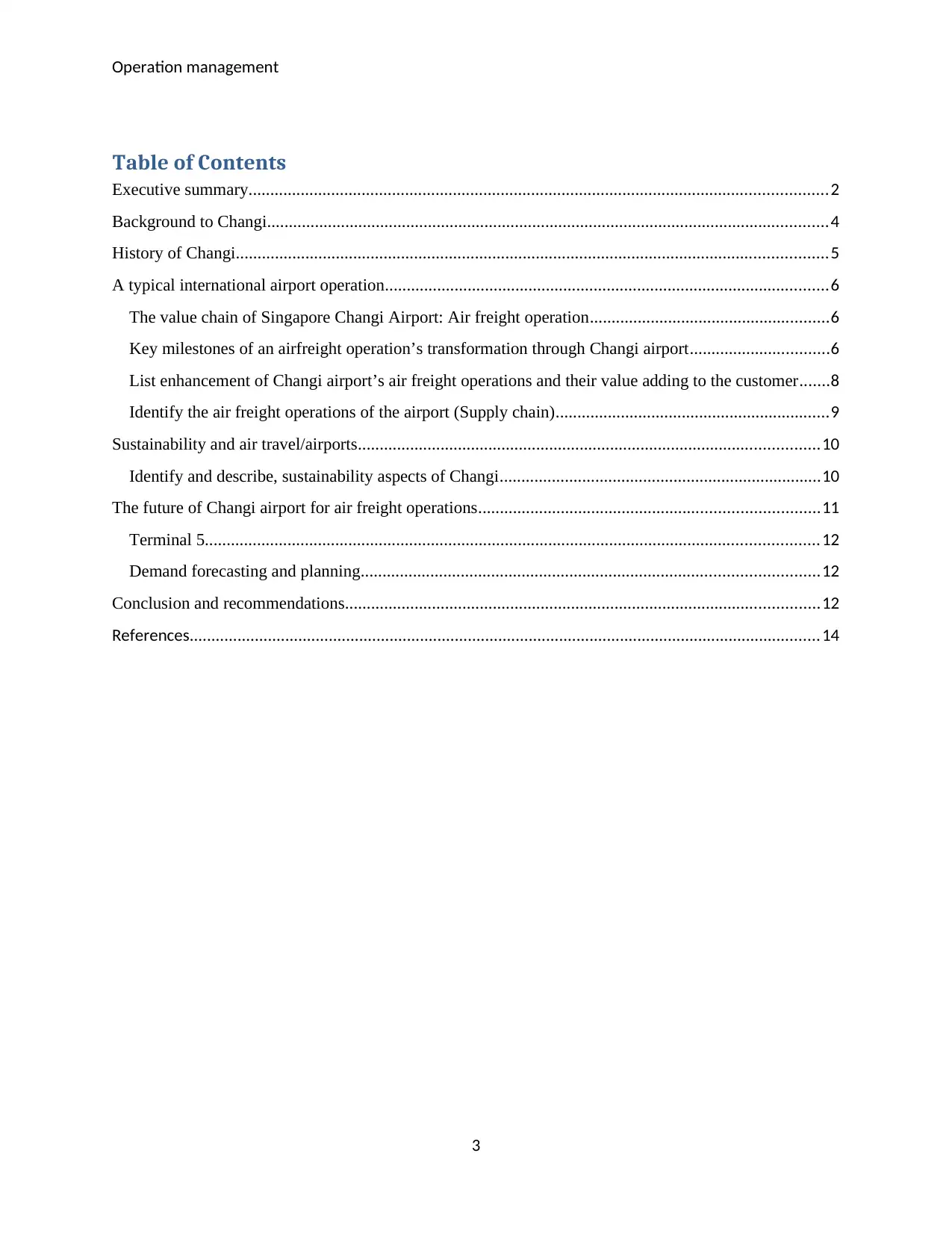
Operation management
Table of Contents
Executive summary.....................................................................................................................................2
Background to Changi.................................................................................................................................4
History of Changi........................................................................................................................................5
A typical international airport operation......................................................................................................6
The value chain of Singapore Changi Airport: Air freight operation.......................................................6
Key milestones of an airfreight operation’s transformation through Changi airport................................6
List enhancement of Changi airport’s air freight operations and their value adding to the customer.......8
Identify the air freight operations of the airport (Supply chain)...............................................................9
Sustainability and air travel/airports..........................................................................................................10
Identify and describe, sustainability aspects of Changi..........................................................................10
The future of Changi airport for air freight operations..............................................................................11
Terminal 5.............................................................................................................................................12
Demand forecasting and planning.........................................................................................................12
Conclusion and recommendations.............................................................................................................12
References.................................................................................................................................................14
3
Table of Contents
Executive summary.....................................................................................................................................2
Background to Changi.................................................................................................................................4
History of Changi........................................................................................................................................5
A typical international airport operation......................................................................................................6
The value chain of Singapore Changi Airport: Air freight operation.......................................................6
Key milestones of an airfreight operation’s transformation through Changi airport................................6
List enhancement of Changi airport’s air freight operations and their value adding to the customer.......8
Identify the air freight operations of the airport (Supply chain)...............................................................9
Sustainability and air travel/airports..........................................................................................................10
Identify and describe, sustainability aspects of Changi..........................................................................10
The future of Changi airport for air freight operations..............................................................................11
Terminal 5.............................................................................................................................................12
Demand forecasting and planning.........................................................................................................12
Conclusion and recommendations.............................................................................................................12
References.................................................................................................................................................14
3
⊘ This is a preview!⊘
Do you want full access?
Subscribe today to unlock all pages.

Trusted by 1+ million students worldwide
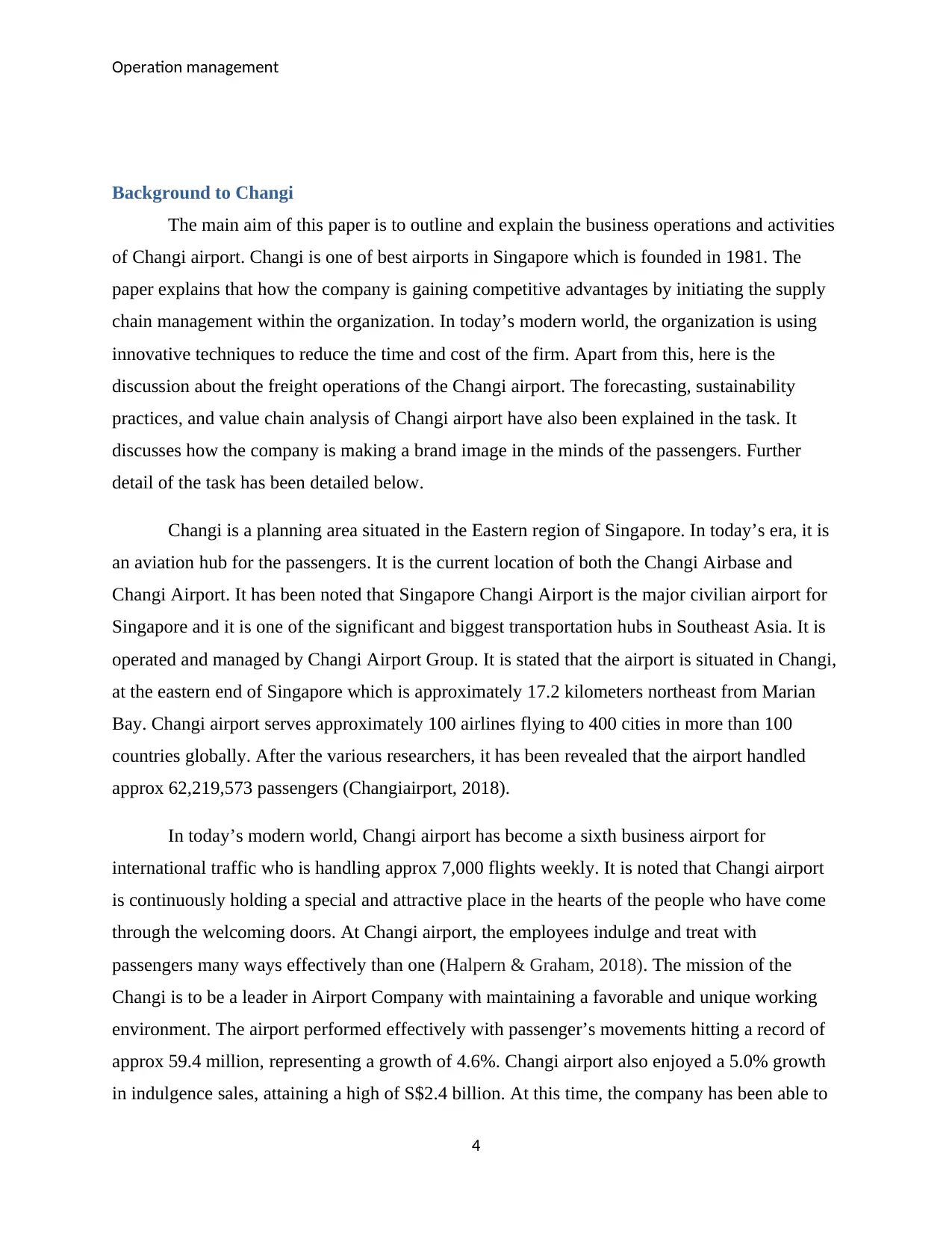
Operation management
Background to Changi
The main aim of this paper is to outline and explain the business operations and activities
of Changi airport. Changi is one of best airports in Singapore which is founded in 1981. The
paper explains that how the company is gaining competitive advantages by initiating the supply
chain management within the organization. In today’s modern world, the organization is using
innovative techniques to reduce the time and cost of the firm. Apart from this, here is the
discussion about the freight operations of the Changi airport. The forecasting, sustainability
practices, and value chain analysis of Changi airport have also been explained in the task. It
discusses how the company is making a brand image in the minds of the passengers. Further
detail of the task has been detailed below.
Changi is a planning area situated in the Eastern region of Singapore. In today’s era, it is
an aviation hub for the passengers. It is the current location of both the Changi Airbase and
Changi Airport. It has been noted that Singapore Changi Airport is the major civilian airport for
Singapore and it is one of the significant and biggest transportation hubs in Southeast Asia. It is
operated and managed by Changi Airport Group. It is stated that the airport is situated in Changi,
at the eastern end of Singapore which is approximately 17.2 kilometers northeast from Marian
Bay. Changi airport serves approximately 100 airlines flying to 400 cities in more than 100
countries globally. After the various researchers, it has been revealed that the airport handled
approx 62,219,573 passengers (Changiairport, 2018).
In today’s modern world, Changi airport has become a sixth business airport for
international traffic who is handling approx 7,000 flights weekly. It is noted that Changi airport
is continuously holding a special and attractive place in the hearts of the people who have come
through the welcoming doors. At Changi airport, the employees indulge and treat with
passengers many ways effectively than one (Halpern & Graham, 2018). The mission of the
Changi is to be a leader in Airport Company with maintaining a favorable and unique working
environment. The airport performed effectively with passenger’s movements hitting a record of
approx 59.4 million, representing a growth of 4.6%. Changi airport also enjoyed a 5.0% growth
in indulgence sales, attaining a high of S$2.4 billion. At this time, the company has been able to
4
Background to Changi
The main aim of this paper is to outline and explain the business operations and activities
of Changi airport. Changi is one of best airports in Singapore which is founded in 1981. The
paper explains that how the company is gaining competitive advantages by initiating the supply
chain management within the organization. In today’s modern world, the organization is using
innovative techniques to reduce the time and cost of the firm. Apart from this, here is the
discussion about the freight operations of the Changi airport. The forecasting, sustainability
practices, and value chain analysis of Changi airport have also been explained in the task. It
discusses how the company is making a brand image in the minds of the passengers. Further
detail of the task has been detailed below.
Changi is a planning area situated in the Eastern region of Singapore. In today’s era, it is
an aviation hub for the passengers. It is the current location of both the Changi Airbase and
Changi Airport. It has been noted that Singapore Changi Airport is the major civilian airport for
Singapore and it is one of the significant and biggest transportation hubs in Southeast Asia. It is
operated and managed by Changi Airport Group. It is stated that the airport is situated in Changi,
at the eastern end of Singapore which is approximately 17.2 kilometers northeast from Marian
Bay. Changi airport serves approximately 100 airlines flying to 400 cities in more than 100
countries globally. After the various researchers, it has been revealed that the airport handled
approx 62,219,573 passengers (Changiairport, 2018).
In today’s modern world, Changi airport has become a sixth business airport for
international traffic who is handling approx 7,000 flights weekly. It is noted that Changi airport
is continuously holding a special and attractive place in the hearts of the people who have come
through the welcoming doors. At Changi airport, the employees indulge and treat with
passengers many ways effectively than one (Halpern & Graham, 2018). The mission of the
Changi is to be a leader in Airport Company with maintaining a favorable and unique working
environment. The airport performed effectively with passenger’s movements hitting a record of
approx 59.4 million, representing a growth of 4.6%. Changi airport also enjoyed a 5.0% growth
in indulgence sales, attaining a high of S$2.4 billion. At this time, the company has been able to
4
Paraphrase This Document
Need a fresh take? Get an instant paraphrase of this document with our AI Paraphraser
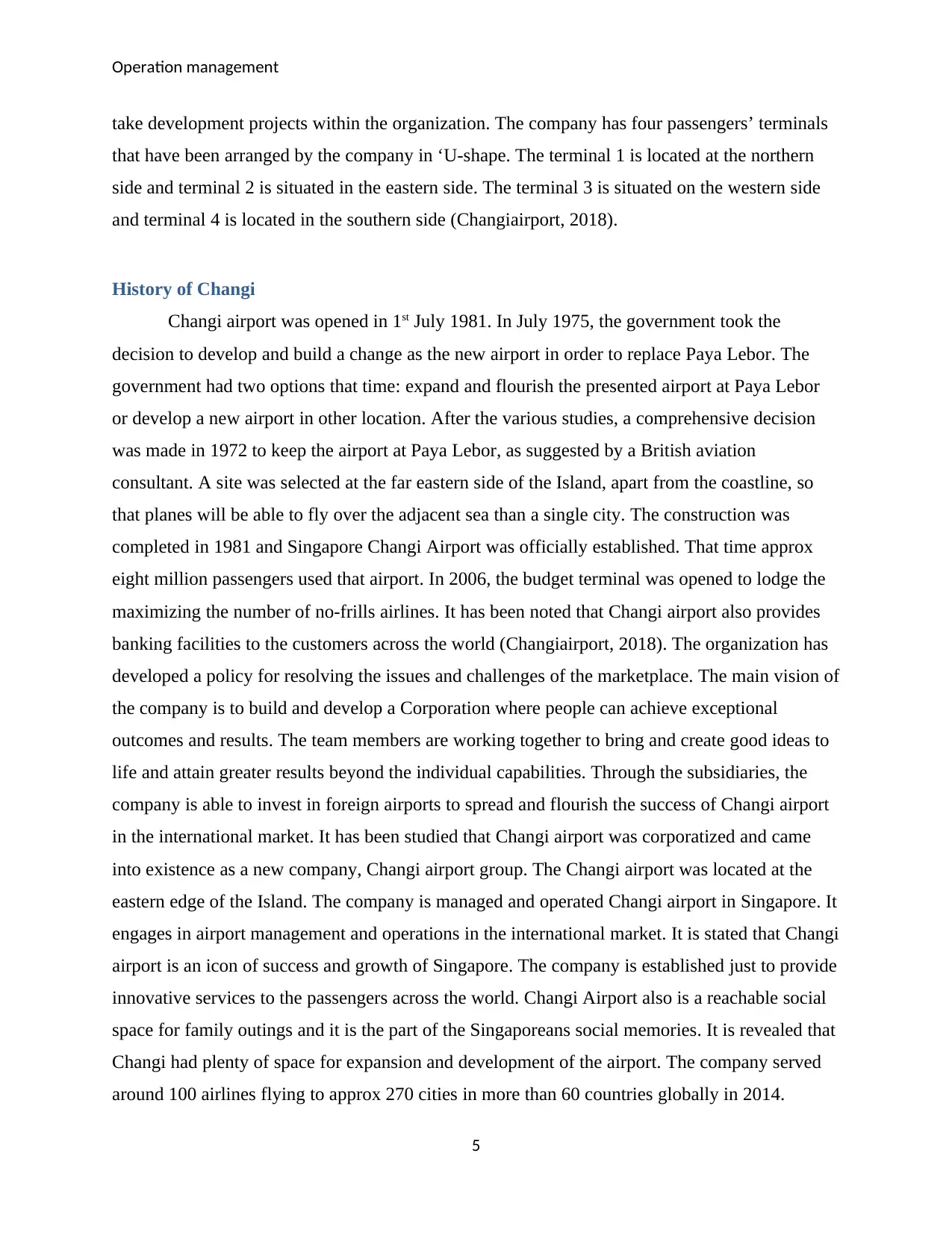
Operation management
take development projects within the organization. The company has four passengers’ terminals
that have been arranged by the company in ‘U-shape. The terminal 1 is located at the northern
side and terminal 2 is situated in the eastern side. The terminal 3 is situated on the western side
and terminal 4 is located in the southern side (Changiairport, 2018).
History of Changi
Changi airport was opened in 1st July 1981. In July 1975, the government took the
decision to develop and build a change as the new airport in order to replace Paya Lebor. The
government had two options that time: expand and flourish the presented airport at Paya Lebor
or develop a new airport in other location. After the various studies, a comprehensive decision
was made in 1972 to keep the airport at Paya Lebor, as suggested by a British aviation
consultant. A site was selected at the far eastern side of the Island, apart from the coastline, so
that planes will be able to fly over the adjacent sea than a single city. The construction was
completed in 1981 and Singapore Changi Airport was officially established. That time approx
eight million passengers used that airport. In 2006, the budget terminal was opened to lodge the
maximizing the number of no-frills airlines. It has been noted that Changi airport also provides
banking facilities to the customers across the world (Changiairport, 2018). The organization has
developed a policy for resolving the issues and challenges of the marketplace. The main vision of
the company is to build and develop a Corporation where people can achieve exceptional
outcomes and results. The team members are working together to bring and create good ideas to
life and attain greater results beyond the individual capabilities. Through the subsidiaries, the
company is able to invest in foreign airports to spread and flourish the success of Changi airport
in the international market. It has been studied that Changi airport was corporatized and came
into existence as a new company, Changi airport group. The Changi airport was located at the
eastern edge of the Island. The company is managed and operated Changi airport in Singapore. It
engages in airport management and operations in the international market. It is stated that Changi
airport is an icon of success and growth of Singapore. The company is established just to provide
innovative services to the passengers across the world. Changi Airport also is a reachable social
space for family outings and it is the part of the Singaporeans social memories. It is revealed that
Changi had plenty of space for expansion and development of the airport. The company served
around 100 airlines flying to approx 270 cities in more than 60 countries globally in 2014.
5
take development projects within the organization. The company has four passengers’ terminals
that have been arranged by the company in ‘U-shape. The terminal 1 is located at the northern
side and terminal 2 is situated in the eastern side. The terminal 3 is situated on the western side
and terminal 4 is located in the southern side (Changiairport, 2018).
History of Changi
Changi airport was opened in 1st July 1981. In July 1975, the government took the
decision to develop and build a change as the new airport in order to replace Paya Lebor. The
government had two options that time: expand and flourish the presented airport at Paya Lebor
or develop a new airport in other location. After the various studies, a comprehensive decision
was made in 1972 to keep the airport at Paya Lebor, as suggested by a British aviation
consultant. A site was selected at the far eastern side of the Island, apart from the coastline, so
that planes will be able to fly over the adjacent sea than a single city. The construction was
completed in 1981 and Singapore Changi Airport was officially established. That time approx
eight million passengers used that airport. In 2006, the budget terminal was opened to lodge the
maximizing the number of no-frills airlines. It has been noted that Changi airport also provides
banking facilities to the customers across the world (Changiairport, 2018). The organization has
developed a policy for resolving the issues and challenges of the marketplace. The main vision of
the company is to build and develop a Corporation where people can achieve exceptional
outcomes and results. The team members are working together to bring and create good ideas to
life and attain greater results beyond the individual capabilities. Through the subsidiaries, the
company is able to invest in foreign airports to spread and flourish the success of Changi airport
in the international market. It has been studied that Changi airport was corporatized and came
into existence as a new company, Changi airport group. The Changi airport was located at the
eastern edge of the Island. The company is managed and operated Changi airport in Singapore. It
engages in airport management and operations in the international market. It is stated that Changi
airport is an icon of success and growth of Singapore. The company is established just to provide
innovative services to the passengers across the world. Changi Airport also is a reachable social
space for family outings and it is the part of the Singaporeans social memories. It is revealed that
Changi had plenty of space for expansion and development of the airport. The company served
around 100 airlines flying to approx 270 cities in more than 60 countries globally in 2014.
5
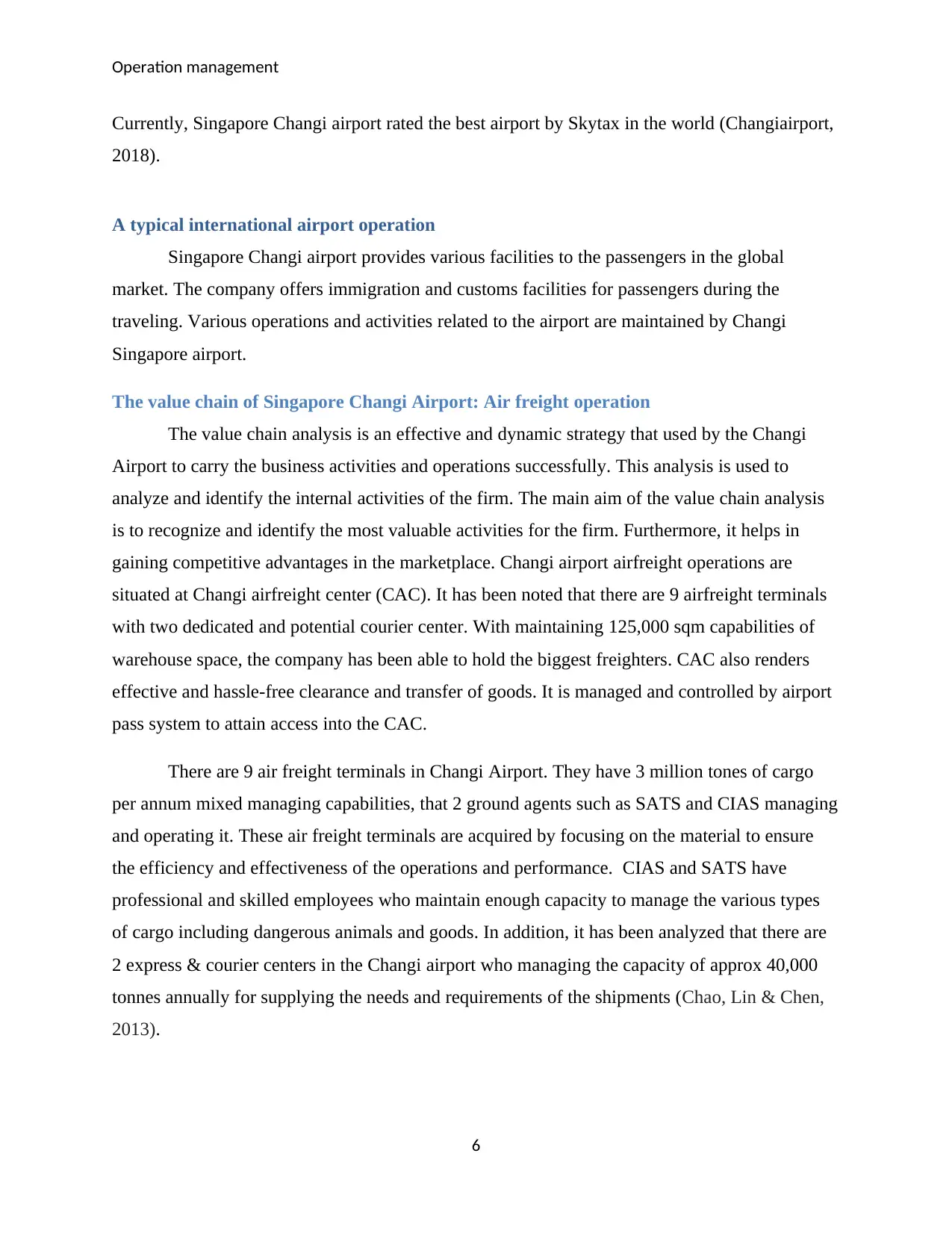
Operation management
Currently, Singapore Changi airport rated the best airport by Skytax in the world (Changiairport,
2018).
A typical international airport operation
Singapore Changi airport provides various facilities to the passengers in the global
market. The company offers immigration and customs facilities for passengers during the
traveling. Various operations and activities related to the airport are maintained by Changi
Singapore airport.
The value chain of Singapore Changi Airport: Air freight operation
The value chain analysis is an effective and dynamic strategy that used by the Changi
Airport to carry the business activities and operations successfully. This analysis is used to
analyze and identify the internal activities of the firm. The main aim of the value chain analysis
is to recognize and identify the most valuable activities for the firm. Furthermore, it helps in
gaining competitive advantages in the marketplace. Changi airport airfreight operations are
situated at Changi airfreight center (CAC). It has been noted that there are 9 airfreight terminals
with two dedicated and potential courier center. With maintaining 125,000 sqm capabilities of
warehouse space, the company has been able to hold the biggest freighters. CAC also renders
effective and hassle-free clearance and transfer of goods. It is managed and controlled by airport
pass system to attain access into the CAC.
There are 9 air freight terminals in Changi Airport. They have 3 million tones of cargo
per annum mixed managing capabilities, that 2 ground agents such as SATS and CIAS managing
and operating it. These air freight terminals are acquired by focusing on the material to ensure
the efficiency and effectiveness of the operations and performance. CIAS and SATS have
professional and skilled employees who maintain enough capacity to manage the various types
of cargo including dangerous animals and goods. In addition, it has been analyzed that there are
2 express & courier centers in the Changi airport who managing the capacity of approx 40,000
tonnes annually for supplying the needs and requirements of the shipments (Chao, Lin & Chen,
2013).
6
Currently, Singapore Changi airport rated the best airport by Skytax in the world (Changiairport,
2018).
A typical international airport operation
Singapore Changi airport provides various facilities to the passengers in the global
market. The company offers immigration and customs facilities for passengers during the
traveling. Various operations and activities related to the airport are maintained by Changi
Singapore airport.
The value chain of Singapore Changi Airport: Air freight operation
The value chain analysis is an effective and dynamic strategy that used by the Changi
Airport to carry the business activities and operations successfully. This analysis is used to
analyze and identify the internal activities of the firm. The main aim of the value chain analysis
is to recognize and identify the most valuable activities for the firm. Furthermore, it helps in
gaining competitive advantages in the marketplace. Changi airport airfreight operations are
situated at Changi airfreight center (CAC). It has been noted that there are 9 airfreight terminals
with two dedicated and potential courier center. With maintaining 125,000 sqm capabilities of
warehouse space, the company has been able to hold the biggest freighters. CAC also renders
effective and hassle-free clearance and transfer of goods. It is managed and controlled by airport
pass system to attain access into the CAC.
There are 9 air freight terminals in Changi Airport. They have 3 million tones of cargo
per annum mixed managing capabilities, that 2 ground agents such as SATS and CIAS managing
and operating it. These air freight terminals are acquired by focusing on the material to ensure
the efficiency and effectiveness of the operations and performance. CIAS and SATS have
professional and skilled employees who maintain enough capacity to manage the various types
of cargo including dangerous animals and goods. In addition, it has been analyzed that there are
2 express & courier centers in the Changi airport who managing the capacity of approx 40,000
tonnes annually for supplying the needs and requirements of the shipments (Chao, Lin & Chen,
2013).
6
⊘ This is a preview!⊘
Do you want full access?
Subscribe today to unlock all pages.

Trusted by 1+ million students worldwide
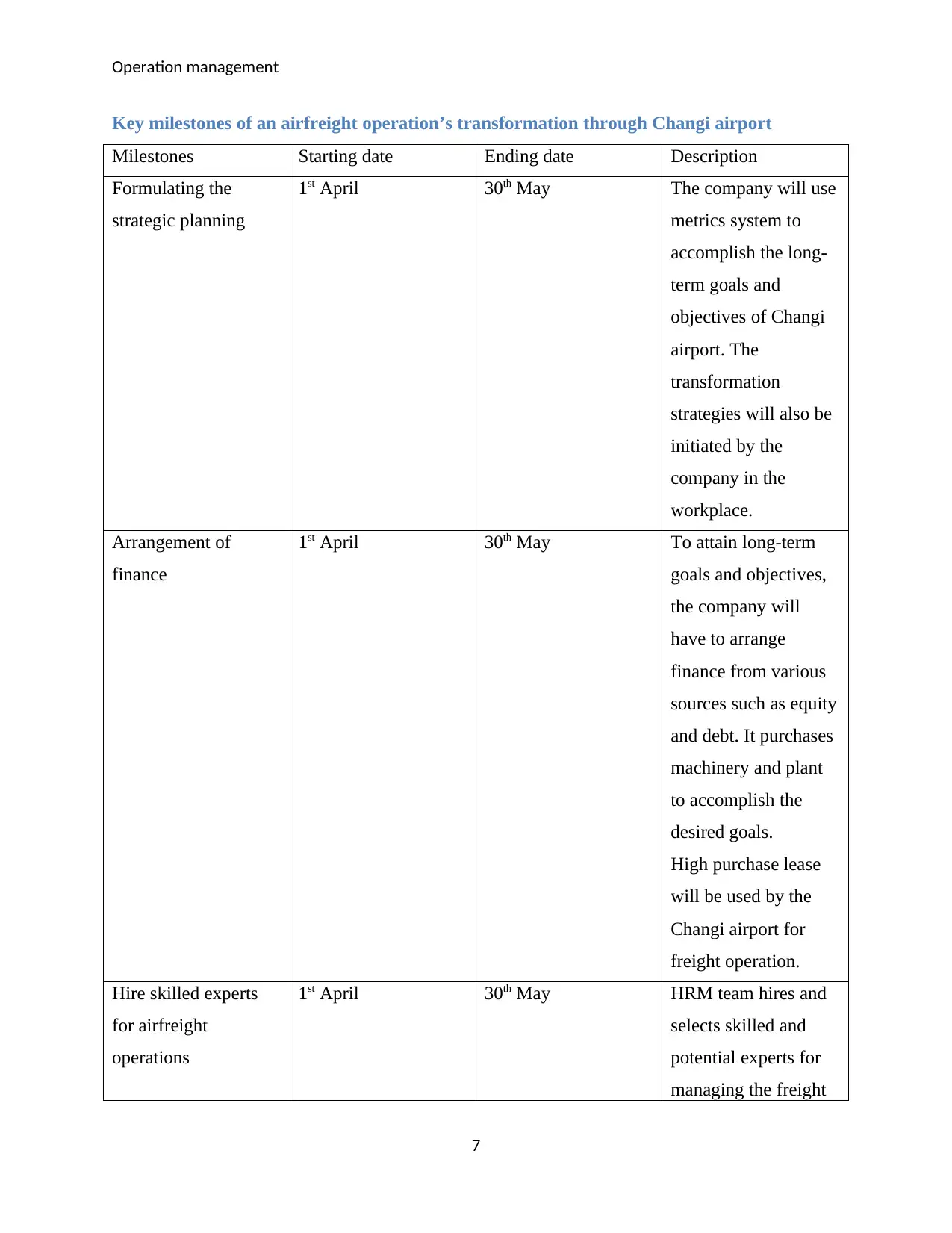
Operation management
Key milestones of an airfreight operation’s transformation through Changi airport
Milestones Starting date Ending date Description
Formulating the
strategic planning
1st April 30th May The company will use
metrics system to
accomplish the long-
term goals and
objectives of Changi
airport. The
transformation
strategies will also be
initiated by the
company in the
workplace.
Arrangement of
finance
1st April 30th May To attain long-term
goals and objectives,
the company will
have to arrange
finance from various
sources such as equity
and debt. It purchases
machinery and plant
to accomplish the
desired goals.
High purchase lease
will be used by the
Changi airport for
freight operation.
Hire skilled experts
for airfreight
operations
1st April 30th May HRM team hires and
selects skilled and
potential experts for
managing the freight
7
Key milestones of an airfreight operation’s transformation through Changi airport
Milestones Starting date Ending date Description
Formulating the
strategic planning
1st April 30th May The company will use
metrics system to
accomplish the long-
term goals and
objectives of Changi
airport. The
transformation
strategies will also be
initiated by the
company in the
workplace.
Arrangement of
finance
1st April 30th May To attain long-term
goals and objectives,
the company will
have to arrange
finance from various
sources such as equity
and debt. It purchases
machinery and plant
to accomplish the
desired goals.
High purchase lease
will be used by the
Changi airport for
freight operation.
Hire skilled experts
for airfreight
operations
1st April 30th May HRM team hires and
selects skilled and
potential experts for
managing the freight
7
Paraphrase This Document
Need a fresh take? Get an instant paraphrase of this document with our AI Paraphraser
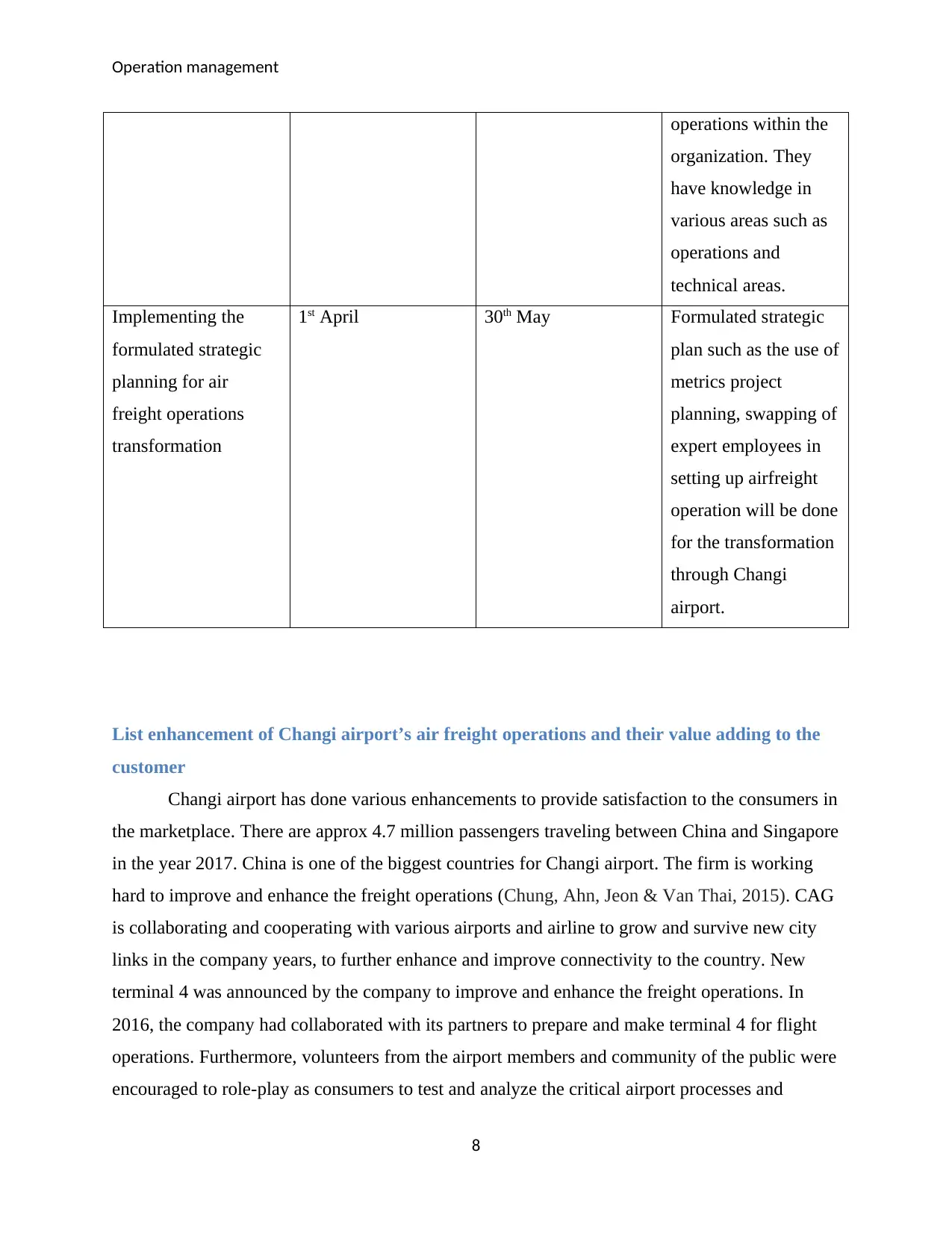
Operation management
operations within the
organization. They
have knowledge in
various areas such as
operations and
technical areas.
Implementing the
formulated strategic
planning for air
freight operations
transformation
1st April 30th May Formulated strategic
plan such as the use of
metrics project
planning, swapping of
expert employees in
setting up airfreight
operation will be done
for the transformation
through Changi
airport.
List enhancement of Changi airport’s air freight operations and their value adding to the
customer
Changi airport has done various enhancements to provide satisfaction to the consumers in
the marketplace. There are approx 4.7 million passengers traveling between China and Singapore
in the year 2017. China is one of the biggest countries for Changi airport. The firm is working
hard to improve and enhance the freight operations (Chung, Ahn, Jeon & Van Thai, 2015). CAG
is collaborating and cooperating with various airports and airline to grow and survive new city
links in the company years, to further enhance and improve connectivity to the country. New
terminal 4 was announced by the company to improve and enhance the freight operations. In
2016, the company had collaborated with its partners to prepare and make terminal 4 for flight
operations. Furthermore, volunteers from the airport members and community of the public were
encouraged to role-play as consumers to test and analyze the critical airport processes and
8
operations within the
organization. They
have knowledge in
various areas such as
operations and
technical areas.
Implementing the
formulated strategic
planning for air
freight operations
transformation
1st April 30th May Formulated strategic
plan such as the use of
metrics project
planning, swapping of
expert employees in
setting up airfreight
operation will be done
for the transformation
through Changi
airport.
List enhancement of Changi airport’s air freight operations and their value adding to the
customer
Changi airport has done various enhancements to provide satisfaction to the consumers in
the marketplace. There are approx 4.7 million passengers traveling between China and Singapore
in the year 2017. China is one of the biggest countries for Changi airport. The firm is working
hard to improve and enhance the freight operations (Chung, Ahn, Jeon & Van Thai, 2015). CAG
is collaborating and cooperating with various airports and airline to grow and survive new city
links in the company years, to further enhance and improve connectivity to the country. New
terminal 4 was announced by the company to improve and enhance the freight operations. In
2016, the company had collaborated with its partners to prepare and make terminal 4 for flight
operations. Furthermore, volunteers from the airport members and community of the public were
encouraged to role-play as consumers to test and analyze the critical airport processes and
8
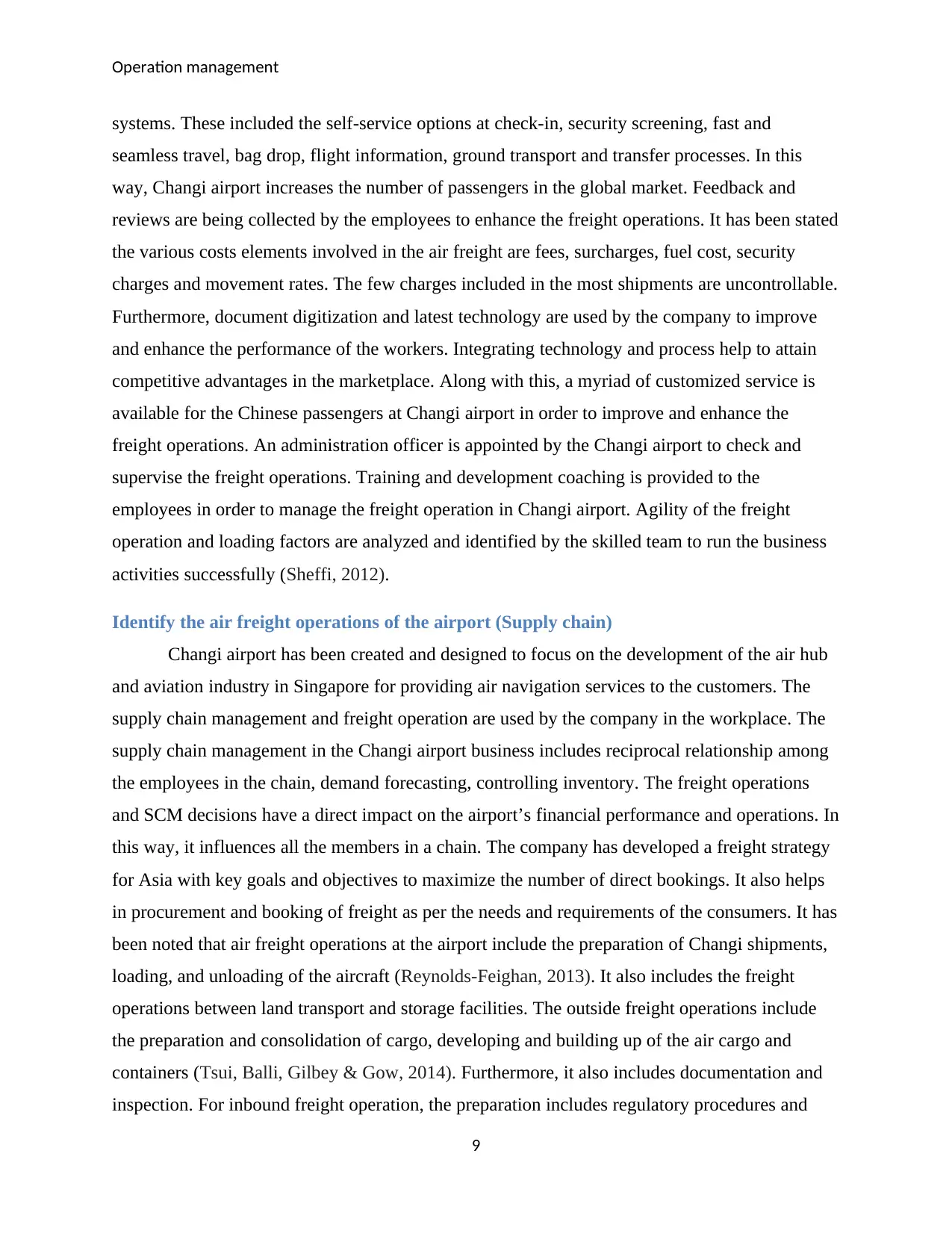
Operation management
systems. These included the self-service options at check-in, security screening, fast and
seamless travel, bag drop, flight information, ground transport and transfer processes. In this
way, Changi airport increases the number of passengers in the global market. Feedback and
reviews are being collected by the employees to enhance the freight operations. It has been stated
the various costs elements involved in the air freight are fees, surcharges, fuel cost, security
charges and movement rates. The few charges included in the most shipments are uncontrollable.
Furthermore, document digitization and latest technology are used by the company to improve
and enhance the performance of the workers. Integrating technology and process help to attain
competitive advantages in the marketplace. Along with this, a myriad of customized service is
available for the Chinese passengers at Changi airport in order to improve and enhance the
freight operations. An administration officer is appointed by the Changi airport to check and
supervise the freight operations. Training and development coaching is provided to the
employees in order to manage the freight operation in Changi airport. Agility of the freight
operation and loading factors are analyzed and identified by the skilled team to run the business
activities successfully (Sheffi, 2012).
Identify the air freight operations of the airport (Supply chain)
Changi airport has been created and designed to focus on the development of the air hub
and aviation industry in Singapore for providing air navigation services to the customers. The
supply chain management and freight operation are used by the company in the workplace. The
supply chain management in the Changi airport business includes reciprocal relationship among
the employees in the chain, demand forecasting, controlling inventory. The freight operations
and SCM decisions have a direct impact on the airport’s financial performance and operations. In
this way, it influences all the members in a chain. The company has developed a freight strategy
for Asia with key goals and objectives to maximize the number of direct bookings. It also helps
in procurement and booking of freight as per the needs and requirements of the consumers. It has
been noted that air freight operations at the airport include the preparation of Changi shipments,
loading, and unloading of the aircraft (Reynolds-Feighan, 2013). It also includes the freight
operations between land transport and storage facilities. The outside freight operations include
the preparation and consolidation of cargo, developing and building up of the air cargo and
containers (Tsui, Balli, Gilbey & Gow, 2014). Furthermore, it also includes documentation and
inspection. For inbound freight operation, the preparation includes regulatory procedures and
9
systems. These included the self-service options at check-in, security screening, fast and
seamless travel, bag drop, flight information, ground transport and transfer processes. In this
way, Changi airport increases the number of passengers in the global market. Feedback and
reviews are being collected by the employees to enhance the freight operations. It has been stated
the various costs elements involved in the air freight are fees, surcharges, fuel cost, security
charges and movement rates. The few charges included in the most shipments are uncontrollable.
Furthermore, document digitization and latest technology are used by the company to improve
and enhance the performance of the workers. Integrating technology and process help to attain
competitive advantages in the marketplace. Along with this, a myriad of customized service is
available for the Chinese passengers at Changi airport in order to improve and enhance the
freight operations. An administration officer is appointed by the Changi airport to check and
supervise the freight operations. Training and development coaching is provided to the
employees in order to manage the freight operation in Changi airport. Agility of the freight
operation and loading factors are analyzed and identified by the skilled team to run the business
activities successfully (Sheffi, 2012).
Identify the air freight operations of the airport (Supply chain)
Changi airport has been created and designed to focus on the development of the air hub
and aviation industry in Singapore for providing air navigation services to the customers. The
supply chain management and freight operation are used by the company in the workplace. The
supply chain management in the Changi airport business includes reciprocal relationship among
the employees in the chain, demand forecasting, controlling inventory. The freight operations
and SCM decisions have a direct impact on the airport’s financial performance and operations. In
this way, it influences all the members in a chain. The company has developed a freight strategy
for Asia with key goals and objectives to maximize the number of direct bookings. It also helps
in procurement and booking of freight as per the needs and requirements of the consumers. It has
been noted that air freight operations at the airport include the preparation of Changi shipments,
loading, and unloading of the aircraft (Reynolds-Feighan, 2013). It also includes the freight
operations between land transport and storage facilities. The outside freight operations include
the preparation and consolidation of cargo, developing and building up of the air cargo and
containers (Tsui, Balli, Gilbey & Gow, 2014). Furthermore, it also includes documentation and
inspection. For inbound freight operation, the preparation includes regulatory procedures and
9
⊘ This is a preview!⊘
Do you want full access?
Subscribe today to unlock all pages.

Trusted by 1+ million students worldwide
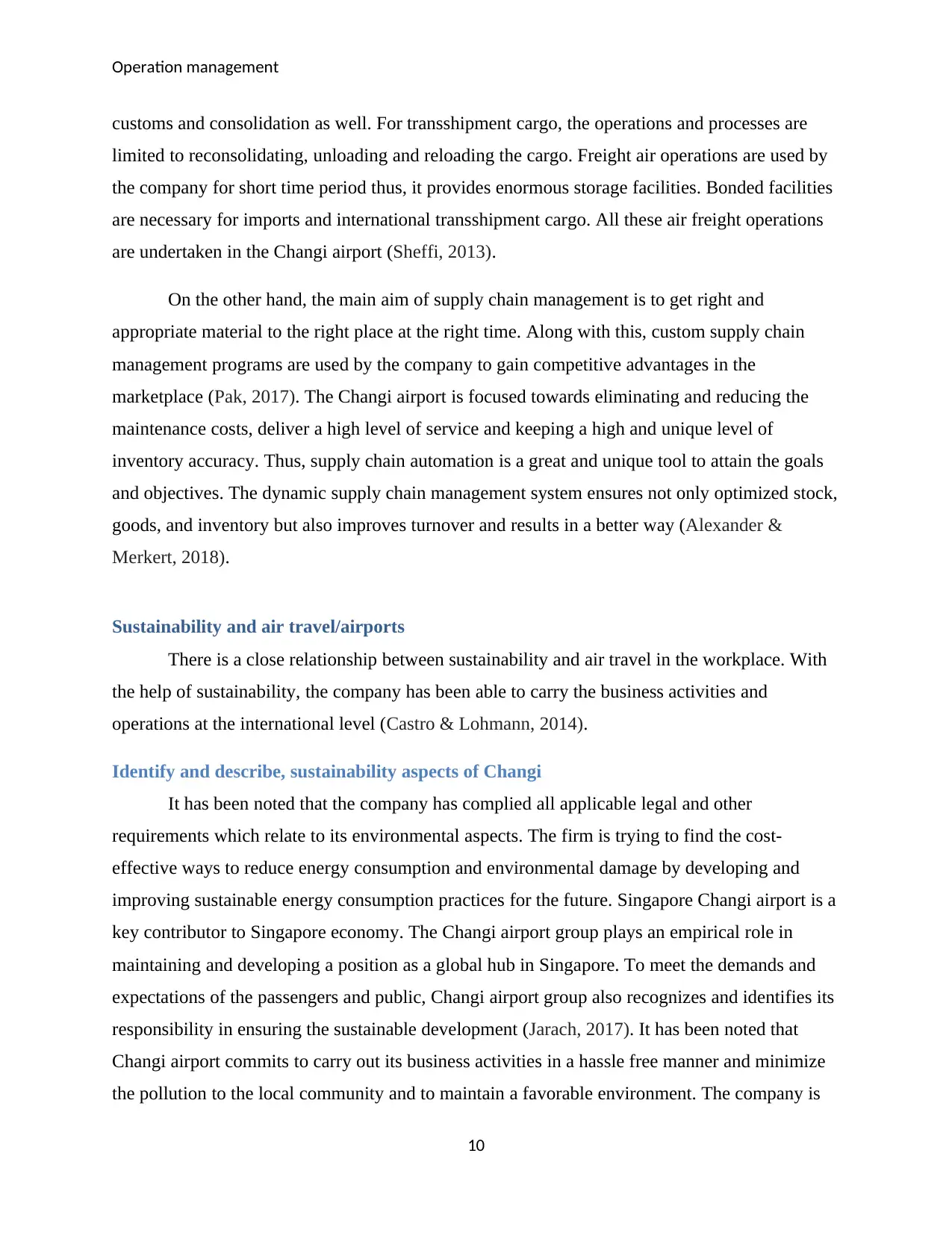
Operation management
customs and consolidation as well. For transshipment cargo, the operations and processes are
limited to reconsolidating, unloading and reloading the cargo. Freight air operations are used by
the company for short time period thus, it provides enormous storage facilities. Bonded facilities
are necessary for imports and international transshipment cargo. All these air freight operations
are undertaken in the Changi airport (Sheffi, 2013).
On the other hand, the main aim of supply chain management is to get right and
appropriate material to the right place at the right time. Along with this, custom supply chain
management programs are used by the company to gain competitive advantages in the
marketplace (Pak, 2017). The Changi airport is focused towards eliminating and reducing the
maintenance costs, deliver a high level of service and keeping a high and unique level of
inventory accuracy. Thus, supply chain automation is a great and unique tool to attain the goals
and objectives. The dynamic supply chain management system ensures not only optimized stock,
goods, and inventory but also improves turnover and results in a better way (Alexander &
Merkert, 2018).
Sustainability and air travel/airports
There is a close relationship between sustainability and air travel in the workplace. With
the help of sustainability, the company has been able to carry the business activities and
operations at the international level (Castro & Lohmann, 2014).
Identify and describe, sustainability aspects of Changi
It has been noted that the company has complied all applicable legal and other
requirements which relate to its environmental aspects. The firm is trying to find the cost-
effective ways to reduce energy consumption and environmental damage by developing and
improving sustainable energy consumption practices for the future. Singapore Changi airport is a
key contributor to Singapore economy. The Changi airport group plays an empirical role in
maintaining and developing a position as a global hub in Singapore. To meet the demands and
expectations of the passengers and public, Changi airport group also recognizes and identifies its
responsibility in ensuring the sustainable development (Jarach, 2017). It has been noted that
Changi airport commits to carry out its business activities in a hassle free manner and minimize
the pollution to the local community and to maintain a favorable environment. The company is
10
customs and consolidation as well. For transshipment cargo, the operations and processes are
limited to reconsolidating, unloading and reloading the cargo. Freight air operations are used by
the company for short time period thus, it provides enormous storage facilities. Bonded facilities
are necessary for imports and international transshipment cargo. All these air freight operations
are undertaken in the Changi airport (Sheffi, 2013).
On the other hand, the main aim of supply chain management is to get right and
appropriate material to the right place at the right time. Along with this, custom supply chain
management programs are used by the company to gain competitive advantages in the
marketplace (Pak, 2017). The Changi airport is focused towards eliminating and reducing the
maintenance costs, deliver a high level of service and keeping a high and unique level of
inventory accuracy. Thus, supply chain automation is a great and unique tool to attain the goals
and objectives. The dynamic supply chain management system ensures not only optimized stock,
goods, and inventory but also improves turnover and results in a better way (Alexander &
Merkert, 2018).
Sustainability and air travel/airports
There is a close relationship between sustainability and air travel in the workplace. With
the help of sustainability, the company has been able to carry the business activities and
operations at the international level (Castro & Lohmann, 2014).
Identify and describe, sustainability aspects of Changi
It has been noted that the company has complied all applicable legal and other
requirements which relate to its environmental aspects. The firm is trying to find the cost-
effective ways to reduce energy consumption and environmental damage by developing and
improving sustainable energy consumption practices for the future. Singapore Changi airport is a
key contributor to Singapore economy. The Changi airport group plays an empirical role in
maintaining and developing a position as a global hub in Singapore. To meet the demands and
expectations of the passengers and public, Changi airport group also recognizes and identifies its
responsibility in ensuring the sustainable development (Jarach, 2017). It has been noted that
Changi airport commits to carry out its business activities in a hassle free manner and minimize
the pollution to the local community and to maintain a favorable environment. The company is
10
Paraphrase This Document
Need a fresh take? Get an instant paraphrase of this document with our AI Paraphraser
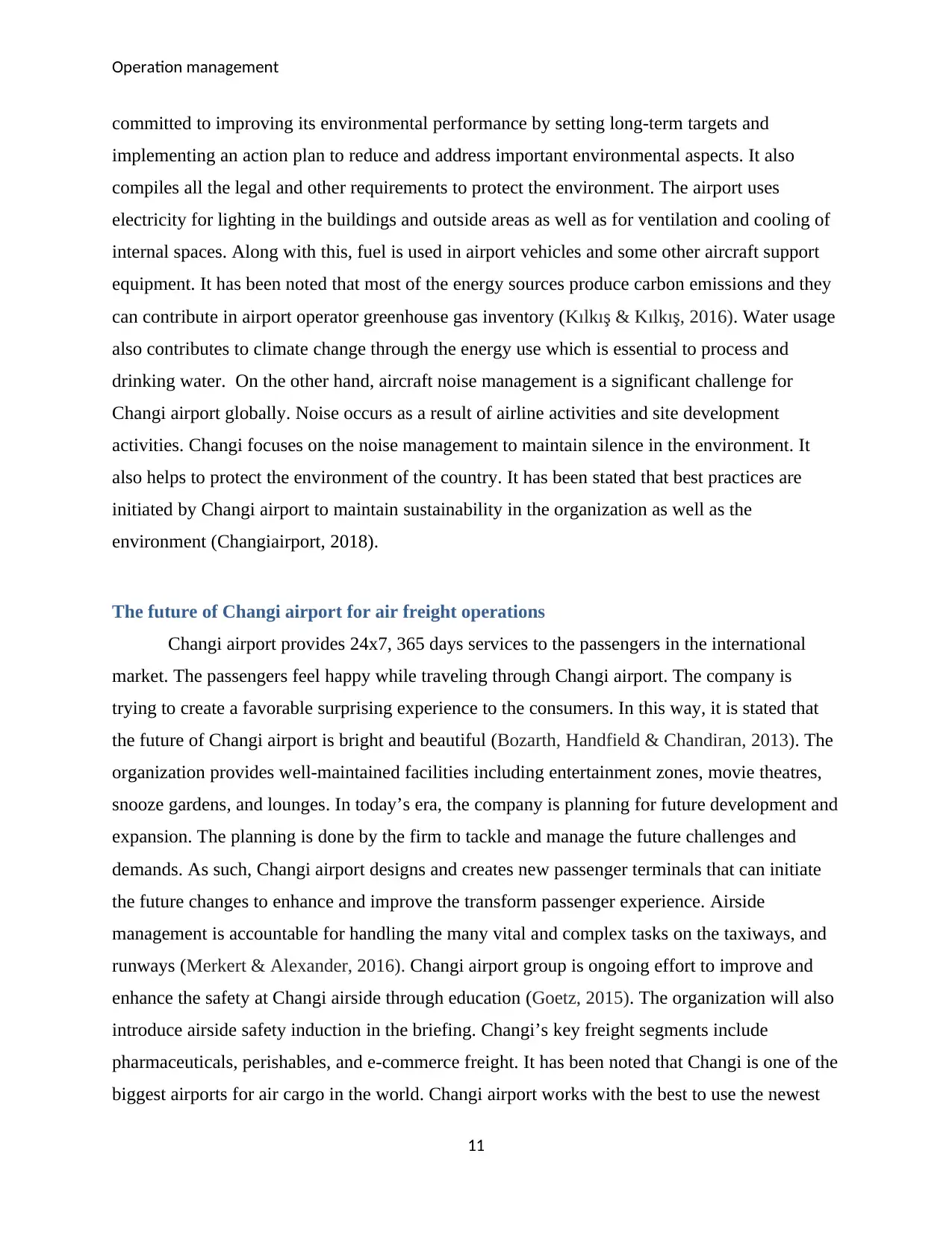
Operation management
committed to improving its environmental performance by setting long-term targets and
implementing an action plan to reduce and address important environmental aspects. It also
compiles all the legal and other requirements to protect the environment. The airport uses
electricity for lighting in the buildings and outside areas as well as for ventilation and cooling of
internal spaces. Along with this, fuel is used in airport vehicles and some other aircraft support
equipment. It has been noted that most of the energy sources produce carbon emissions and they
can contribute in airport operator greenhouse gas inventory (Kılkış & Kılkış, 2016). Water usage
also contributes to climate change through the energy use which is essential to process and
drinking water. On the other hand, aircraft noise management is a significant challenge for
Changi airport globally. Noise occurs as a result of airline activities and site development
activities. Changi focuses on the noise management to maintain silence in the environment. It
also helps to protect the environment of the country. It has been stated that best practices are
initiated by Changi airport to maintain sustainability in the organization as well as the
environment (Changiairport, 2018).
The future of Changi airport for air freight operations
Changi airport provides 24x7, 365 days services to the passengers in the international
market. The passengers feel happy while traveling through Changi airport. The company is
trying to create a favorable surprising experience to the consumers. In this way, it is stated that
the future of Changi airport is bright and beautiful (Bozarth, Handfield & Chandiran, 2013). The
organization provides well-maintained facilities including entertainment zones, movie theatres,
snooze gardens, and lounges. In today’s era, the company is planning for future development and
expansion. The planning is done by the firm to tackle and manage the future challenges and
demands. As such, Changi airport designs and creates new passenger terminals that can initiate
the future changes to enhance and improve the transform passenger experience. Airside
management is accountable for handling the many vital and complex tasks on the taxiways, and
runways (Merkert & Alexander, 2016). Changi airport group is ongoing effort to improve and
enhance the safety at Changi airside through education (Goetz, 2015). The organization will also
introduce airside safety induction in the briefing. Changi’s key freight segments include
pharmaceuticals, perishables, and e-commerce freight. It has been noted that Changi is one of the
biggest airports for air cargo in the world. Changi airport works with the best to use the newest
11
committed to improving its environmental performance by setting long-term targets and
implementing an action plan to reduce and address important environmental aspects. It also
compiles all the legal and other requirements to protect the environment. The airport uses
electricity for lighting in the buildings and outside areas as well as for ventilation and cooling of
internal spaces. Along with this, fuel is used in airport vehicles and some other aircraft support
equipment. It has been noted that most of the energy sources produce carbon emissions and they
can contribute in airport operator greenhouse gas inventory (Kılkış & Kılkış, 2016). Water usage
also contributes to climate change through the energy use which is essential to process and
drinking water. On the other hand, aircraft noise management is a significant challenge for
Changi airport globally. Noise occurs as a result of airline activities and site development
activities. Changi focuses on the noise management to maintain silence in the environment. It
also helps to protect the environment of the country. It has been stated that best practices are
initiated by Changi airport to maintain sustainability in the organization as well as the
environment (Changiairport, 2018).
The future of Changi airport for air freight operations
Changi airport provides 24x7, 365 days services to the passengers in the international
market. The passengers feel happy while traveling through Changi airport. The company is
trying to create a favorable surprising experience to the consumers. In this way, it is stated that
the future of Changi airport is bright and beautiful (Bozarth, Handfield & Chandiran, 2013). The
organization provides well-maintained facilities including entertainment zones, movie theatres,
snooze gardens, and lounges. In today’s era, the company is planning for future development and
expansion. The planning is done by the firm to tackle and manage the future challenges and
demands. As such, Changi airport designs and creates new passenger terminals that can initiate
the future changes to enhance and improve the transform passenger experience. Airside
management is accountable for handling the many vital and complex tasks on the taxiways, and
runways (Merkert & Alexander, 2016). Changi airport group is ongoing effort to improve and
enhance the safety at Changi airside through education (Goetz, 2015). The organization will also
introduce airside safety induction in the briefing. Changi’s key freight segments include
pharmaceuticals, perishables, and e-commerce freight. It has been noted that Changi is one of the
biggest airports for air cargo in the world. Changi airport works with the best to use the newest
11
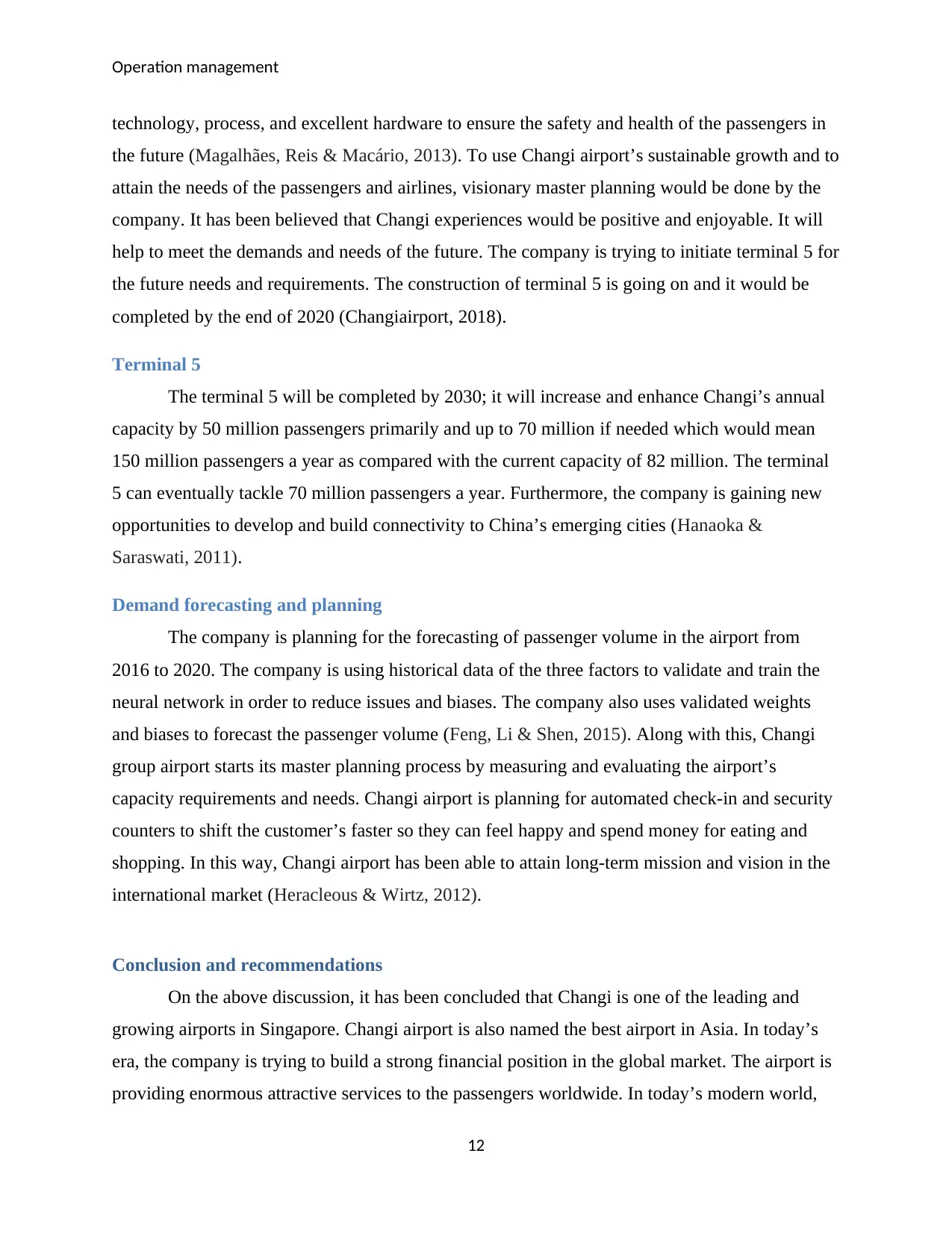
Operation management
technology, process, and excellent hardware to ensure the safety and health of the passengers in
the future (Magalhães, Reis & Macário, 2013). To use Changi airport’s sustainable growth and to
attain the needs of the passengers and airlines, visionary master planning would be done by the
company. It has been believed that Changi experiences would be positive and enjoyable. It will
help to meet the demands and needs of the future. The company is trying to initiate terminal 5 for
the future needs and requirements. The construction of terminal 5 is going on and it would be
completed by the end of 2020 (Changiairport, 2018).
Terminal 5
The terminal 5 will be completed by 2030; it will increase and enhance Changi’s annual
capacity by 50 million passengers primarily and up to 70 million if needed which would mean
150 million passengers a year as compared with the current capacity of 82 million. The terminal
5 can eventually tackle 70 million passengers a year. Furthermore, the company is gaining new
opportunities to develop and build connectivity to China’s emerging cities (Hanaoka &
Saraswati, 2011).
Demand forecasting and planning
The company is planning for the forecasting of passenger volume in the airport from
2016 to 2020. The company is using historical data of the three factors to validate and train the
neural network in order to reduce issues and biases. The company also uses validated weights
and biases to forecast the passenger volume (Feng, Li & Shen, 2015). Along with this, Changi
group airport starts its master planning process by measuring and evaluating the airport’s
capacity requirements and needs. Changi airport is planning for automated check-in and security
counters to shift the customer’s faster so they can feel happy and spend money for eating and
shopping. In this way, Changi airport has been able to attain long-term mission and vision in the
international market (Heracleous & Wirtz, 2012).
Conclusion and recommendations
On the above discussion, it has been concluded that Changi is one of the leading and
growing airports in Singapore. Changi airport is also named the best airport in Asia. In today’s
era, the company is trying to build a strong financial position in the global market. The airport is
providing enormous attractive services to the passengers worldwide. In today’s modern world,
12
technology, process, and excellent hardware to ensure the safety and health of the passengers in
the future (Magalhães, Reis & Macário, 2013). To use Changi airport’s sustainable growth and to
attain the needs of the passengers and airlines, visionary master planning would be done by the
company. It has been believed that Changi experiences would be positive and enjoyable. It will
help to meet the demands and needs of the future. The company is trying to initiate terminal 5 for
the future needs and requirements. The construction of terminal 5 is going on and it would be
completed by the end of 2020 (Changiairport, 2018).
Terminal 5
The terminal 5 will be completed by 2030; it will increase and enhance Changi’s annual
capacity by 50 million passengers primarily and up to 70 million if needed which would mean
150 million passengers a year as compared with the current capacity of 82 million. The terminal
5 can eventually tackle 70 million passengers a year. Furthermore, the company is gaining new
opportunities to develop and build connectivity to China’s emerging cities (Hanaoka &
Saraswati, 2011).
Demand forecasting and planning
The company is planning for the forecasting of passenger volume in the airport from
2016 to 2020. The company is using historical data of the three factors to validate and train the
neural network in order to reduce issues and biases. The company also uses validated weights
and biases to forecast the passenger volume (Feng, Li & Shen, 2015). Along with this, Changi
group airport starts its master planning process by measuring and evaluating the airport’s
capacity requirements and needs. Changi airport is planning for automated check-in and security
counters to shift the customer’s faster so they can feel happy and spend money for eating and
shopping. In this way, Changi airport has been able to attain long-term mission and vision in the
international market (Heracleous & Wirtz, 2012).
Conclusion and recommendations
On the above discussion, it has been concluded that Changi is one of the leading and
growing airports in Singapore. Changi airport is also named the best airport in Asia. In today’s
era, the company is trying to build a strong financial position in the global market. The airport is
providing enormous attractive services to the passengers worldwide. In today’s modern world,
12
⊘ This is a preview!⊘
Do you want full access?
Subscribe today to unlock all pages.

Trusted by 1+ million students worldwide
1 out of 16
Related Documents
Your All-in-One AI-Powered Toolkit for Academic Success.
+13062052269
info@desklib.com
Available 24*7 on WhatsApp / Email
![[object Object]](/_next/static/media/star-bottom.7253800d.svg)
Unlock your academic potential
Copyright © 2020–2025 A2Z Services. All Rights Reserved. Developed and managed by ZUCOL.



